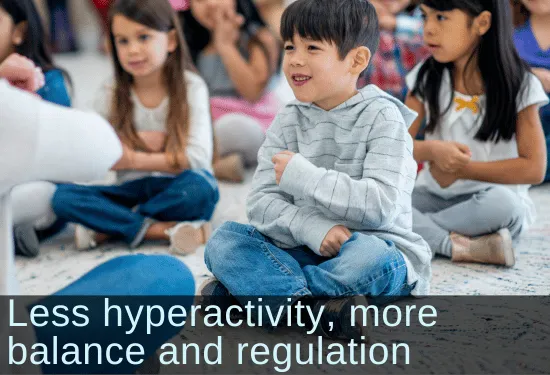Primitive Reflex Integration Case Studies
Reflex Integration Improves Balance and Behavior
In six weeks, 5-year-old is less hyperactive and better able to sit upright
This hyperactive preschooler experienced significant balance and postural challenges. He constantly leaned or fell onto nearby people or objects when sitting, and frequently lost his balance while walking. Using rhythmic movements and reflex integration from the Brain and Sensory Foundations course, his OT helped him significantly improve his balance and regulation—he went from being unable to sit still for longer than 5 seconds, to remaining seated and upright for 15 minutes.
Submitted by S.G., MS, OTR/L
School District Occupational Therapist

| Before | After |
|---|---|
| Could not sit for more than 3-5 seconds without falling over or leaning heavily on furniture or people | Sitting 15 minutes at circle time with his classmates |
| Unable to keep within his own space during circle time | No longer leaning into classmates during circle time |
| Would fall over when attempting to do cross-lateral movements in standing | Able to complete standing cross crawls with only one loss of balance, then caught himself |
| Significant coordination and motor-planning challenges | Increasing control and coordination between upper and lower body |
This case study highlights school therapy pushing into a developmentally delayed pre-k classroom. The student is a 5-year-old boy with significant difficulties standing or sitting for longer than 3-5 seconds without falling or leaning heavily on furniture or people. During carpet time in class he is observed to be rolling on the floor and has difficulty sitting up with or without a floor based chair. His teacher has taped off a visual marker for the space he should stay in but he is unable to stay within that space. We have used a weighted vest, fidgets, heavy work activities and deep pressure in the past with no lasting effects. He displays extreme hyperactivity, impulsivity and has difficulty with constant talking and interrupting of peers and adults. He walks on his tiptoes and falls over often with loss of balance. Sweet temperament and wants to please adults. Loves and craves hugs and verbal affirmation.
Sessions were approximately 10-15 minutes each, 1-2x a week for a period of two months with a couple of student absences.
Sessions began with Brain Tune Up [from the Brain and Sensory Foundations course]. Since this is a student I have worked with for over a year, we had already established a heart connection in therapy sessions. He exhibited some giggling at the beginning of the sequence, and he fell over when attempting to do the cross-lateral movements in standing. He was unable to motor-plan the last part of the Brain Tune Up.
I noted some calming upon doing rhythmic movements [from the Brain and Sensory Foundations course] in the beginning, however effects were not seen for at least 4 weeks for carryover past a few minutes. As we progressed, rhythmic movements 1-4 were trialed and student preferred #2b most, tolerating it for at least 2 minutes before distraction set in. After many sessions of rhythmic movements and acclimation to movements, the teacher was also trained to administer as able throughout the week. Mom was also sent home program with movements however she reported that she never got around to doing them at home.
TLR [Tonic Labyrinthine Reflex] was the first reflex we stimulated and then worked on integration because he shows many of the signs such as significant balance issues, shrunken posture, muscle tone imbalances, difficulties judging depth perception, space and speed; visual, speech and auditory difficulties, stiff jerky movements; toe walking; difficulty walking up and down stairs safely, difficulty following directional or movement instructions and poor core strength. Worked on the TLR fun activities [from the Brain and Sensory Foundations course] for integration. Initially only 5-6 reps of one of the activities was tolerated before fatiguing; this increased to 10 reps by two months.
At the four-week mark the student was able to complete standing cross crawls with only one loss of balance, during which he was able to catch himself before falling to the floor. The last part of the Brain Tune Up was now able to be completed with minimal assistance. When working on TLR integration with isometrics, he struggled with lots of cues to not push so hard. With the fun activities he showed increasing control and coordination between upper and lower body. After six weeks, in his general education classroom he was able to sit cross legged for 15 minutes with no falling over, and staying within his given space on carpet. The longest he has ever done! The special education teacher was skeptical about him sitting still when reported to her but the general education teacher and a classroom assistant both confirmed it.
Working with this student has shown me how to adapt to the needs of the child and start with what we can do successfully. I was able to slow down and more systematically teach him in smaller increments. These movements helped a student who could not sit for 3-5 seconds without rolling over to sitting 15 minutes on a carpet with his peers in a full general education classroom.
(Edited, emphasis added)
*Disclaimer: The activities in the Brain and Sensory Foundations curriculum make use of the natural processes of neuroplasticity and development that are innately wired in the design of human beings to promote maturity and function. These activities appear to calm, organize, and mature the neuro-sensory-motor systems just as we see in the healthy development of human infants. Individual results may vary, and we do not claim to offer a diagnosis or cure for any specific condition or disorder. The Brain and Sensory Foundations activities appear to improve overall functioning resulting in measurable improvements for a range of conditions as demonstrated in over 1800 case studies from participants.

